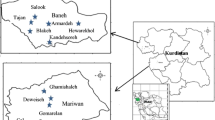Abstract
To investigate the genetic diversity of Tricholoma matsutake, we studied ITS and IGS1 sequences and PCR polymorphism of a retrotransposon in 56 fruit bodies collected from 13 counties of 9 regions in Yunnan Province. We found one and three haplotypes based on ITS and IGS1 sequences, respectively. Moreover, there was no significant difference in PCR polymorphism of the retrotransposon among different populations. Compared with Jilin Province (China) and Japanese populations, although Yunnan was highly homogenous to Japanese populations, low genetic diversity of T. matsutake in Yunnan did not support the view that this species originated from Yunnan.
Similar content being viewed by others
References
Gill W M, Lapeyrie F, Gomi T, et al. Tricholoma matsutake: An assessment of in situ and in vitro infection by observing cleared and stained whole roots. Mycorrhiza, 1999, 9: 227–231
Yamada A, Kobayashi H, Murata H. Tricholoma matsutake IFO6933 and IFO30604, “matsutake” isolates that have been maintained on slants and widely used in vitro for a quarter to half a century, can form ectomycorrhiza in Pinus densiflora. Mycoscience, 2003, 44: 249–251
Gong M Q, Wang F Z, Chen Y. Protecting the eco-environment of Tricholoma matsutake and improving its sustainable development. Forest Res (in Chinese), 2000, 13(5): 562–567
Liu P G, Yuan M S, Wang X H, et al. Notes on the resources of matsutake group and their reasonable utilization as well as effective conservation in China. J Nat Resour (in Chinese), 1999, 14(3): 245–252
Horton T R. Molecular approaches to ectomycorrhizal diversity studies: Variation in ITS at a local scale. Plant Soil, 2002, 244: 29–39
Vaario L M, Li Y H. Current trends of Tricholoma matsutake research. Acta Edulis Fungi (in Chinese), 2003, 10(3): 49–55
James T Y, Moncalvo J M, Li S, et al. Polymorphism at the ribosomal DNA spacers and its relation to breeding structure of the widespread mushroom Schizophyllum commune. Genetics, 2001, 157: 149–161
Guerin-Laguette A, Matsushita N, Kikuchi K, et al. Identification of a prevalent Tricholoma matsutake ribotype in Japan by rDNA IGS1 spacer characterization. Mycol Res, 2000, 106: 435–443
Kalendar R, Grob T, Regina M, et al. IRAP and REMAP: Two new retrotransposon-based DNA fingerprinting techniques. Theor Appl Genet, 1999, 98: 704–711
Murata H, Babasaki K, Yamada A. Highly polymorphic DNA markers to specify strains of the ectomycorrhizal basidiomycete Tricholoma matsutake based on σmarY1, the long terminal repeat of gypsy-type retroelement marY1. Mycorrhiza, 2005, 15: 179–186
Sha T, Ding H S, Li M, et al. Sequence analysis of the internal transcribed spacer of gene coding for rRNA in Tricholoma matsutake and Tricholoma bakamatsutake. Mycosystema (in Chinese), 2005, 24(1): 48–52
Nei M. Analysis of gene diversity in subdivided populations. Proc Natl Acad Sci USA, 1973, 70: 3321–3323
Lewontin R C. Population genetics. Annu Rev Genet, 1973, 7: 1–17
Matsushita N, Kikuchi K, Sasaki Y, et al. Genetic relationship of Tricholoma matsutake and T. nauseosum from the northern hemisphere based on analyses of ribosomal DNA spacer regions. Mycoscience, 2005, 46: 90–96
Fu W J, Xu G B, Liu J S, et al. Research on distribution and ecological environment of Tricholoma matsutake in Changbai mountain area. Acta Edulis Fungi (in Chinese), 1996, 3(3): 46–50
Lian C L, Narimatsu M, Nara K, et al. Tricholoma matsutake in a natural Pinus densiflora forest: correspondence between above-and below-ground genets, association with multiple host trees and alteration of existing ectomycorrhizal communities. New Phytol, 2006, 171:825–836
Chapela I H, Garbelotto M. Phylogeography and evolution in matsutake and close allies inferred by analyses of ITS sequences and AFLPs. Mycologia, 2004, 96: 730–741
Chen S Y, Zhang Y P. Genetic approaches to study origins of domestic animals. Chin Sci Bull (in Chinese), 2006, 51(21): 2469–2475
Author information
Authors and Affiliations
Corresponding author
Additional information
Supported by the 10th Five-year Chinese National Programms for Science and Technology Development (Grant No. 2001BA707B01), National Natural Science Foundation of China (Grant No. 30621092), and Natural Science Foundation of Yunnan Province (Grant No. 2005PG11)
About this article
Cite this article
Sha, T., Zhang, H., Ding, H. et al. Genetic diversity of Tricholoma matsutake in Yunnan Province. CHINESE SCI BULL 52, 1212–1216 (2007). https://doi.org/10.1007/s11434-007-0194-0
Received:
Accepted:
Issue Date:
DOI: https://doi.org/10.1007/s11434-007-0194-0




